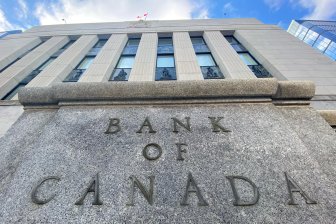The Bank of Canada raised its benchmark interest rate three-quarters of a percentage point on Wednesday and signalled that the key rate “will need to rise further” to tackle high levels of inflation.
The central bank’s policy rate now stands at 3.25 per cent.
This marks the fifth rate hike so far in 2022 — Canada’s key interest rate sat at just 0.25 per cent in January.
Markets and economists had largely expected the 75 basis point move, which followed a supersized rate hike of a full percentage point in July.
The Bank of Canada raises interest rates in an effort to take steam out of the Canadian economy and discourage consumer spending demand, dampening domestic fuel for inflation.
The central bank said in a statement that while second quarter economic growth was a bit below its estimate, domestic demand remains “very strong” and the labour market is still tight.

Passing the three per cent bar is significant, as it takes the bank’s policy rate past what it believes to be the “neutral range” and into territory where it is now actively suppressing economic growth.
The annual inflation rate hit 7.6 per cent in July, a slight decline from 8.1 per cent in June, as gasoline prices dropped across Canada.
But the Bank of Canada in its statement noted that inflation without gas prices increased and broadened last month, especially in the services sector. The central bank’s core inflation measure ticked up to 5.5 per cent in July, compared with 5.0 per cent the month previous.
“The longer this continues, the greater the risk that elevated inflation becomes entrenched,” the bank said, justifying its call for even higher rates.
How high will interest rates go?
CIBC chief economist Avery Shenfeld said in a note Wednesday morning after the rate hike decision that the central bank was “a bit more hawkish” than it expected.
CIBC, which had previously called for the bank to pause after a 75-basis-point hike, now expects “at least” a quarter percentage point increase at the Bank of Canada’s next decision on Oct. 26.
Royal Bank of Canada also has the benchmark interest rate reaching 3.5 per cent in the fall. RBC continues to predict a “mild recession” in 2023.

BMO is “pencilling in” a half-percentage-point increase in October, but stronger or weaker inflation data could sway that call before then, according to Benjamin Reitzes, the bank’s managing director of Canadian rates and macro strategist.
TD Bank senior economist James Orlando said in a note that the bank now expects the key policy rate to hit 4.0 per cent by the end of the year, a move which would take even more steam out of Canada’s economy.
“This implies even more growth sacrifice as the BoC attempts to achieve its goal of price stability,” he wrote.
What does the interest rate hike mean for the housing market?
When the Bank of Canada raises its benchmark interest rate, mortgages and certain loans become more expensive to carry. Adjustable rate mortgages and home-equity lines of credit immediately see their interest rates rise in step with the central bank hikes, while fixed-rate mortgage holders pay more when they renew their term.
According to comparator site Ratehub.ca, the owner of a home worth $630,000 who had a 3.5 per cent variable-rate mortgage before this hike will pay an extra $236 per month — $2,832 more per year — as their rate now rises to 4.25 per cent with a monthly payment of $3,155.
The central bank’s statement Wednesday said that with mortgage rates rising over the past seven months, the “housing market is pulling back as anticipated,” calling the growth in home prices seen over the pandemic “unsustainable.”
RBC assistant chief economist Robert Hogue said in a report Wednesday that higher interest rates this fall “will keep chilling markets in the months ahead. ”
“We see the downturn intensifying and spreading as buyers take a wait-and-see approach while ascertaining the impact of higher lending rates,” he wrote.
Hogue said Vancouver and Toronto, as well as their surrounding regions, are most at risk of a pullback, citing their “outsized price gains” during the pandemic.




Post a Comment